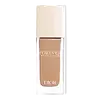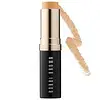What's inside
What's inside
 Key Ingredients
Key Ingredients

 Benefits
Benefits

 Concerns
Concerns

 Ingredients Side-by-side
Ingredients Side-by-side

Water
Skin ConditioningC9-12 Alkane
SolventCaprylic/Capric Triglyceride
MaskingPropanediol
SolventGlycerin
HumectantCoco-Caprylate/Caprate
EmollientC15-19 Alkane
SolventPentylene Glycol
Skin ConditioningPullulan
Sorbitan Sesquiisostearate
EmulsifyingStearalkonium Hectorite
Gel FormingTrimethylsiloxysilicate
EmollientPolyglyceryl-3 Polyricinoleate
EmulsifyingPolyglyceryl-3 Diisostearate
EmulsifyingParfum
MaskingSodium Chloride
MaskingButylene Glycol
HumectantSodium Myristoyl Glutamate
CleansingHydroxyacetophenone
AntioxidantEthylhexylglycerin
Skin ConditioningPotassium Sorbate
PreservativeHibiscus Sabdariffa Flower Extract
Skin ConditioningAluminum Hydroxide
EmollientPolyhydroxystearic Acid
EmulsifyingHydrolyzed Viola Tricolor Extract
Skin ProtectingRosa Multiflora Fruit Extract
MaskingTropaeolum Majus Flower/Leaf/Stem Extract
Skin Conditioning1,2-Hexanediol
Skin ConditioningCaprylyl Glycol
EmollientIsostearic Acid
CleansingLecithin
EmollientCitric Acid
BufferingTocopherol
AntioxidantCI 77491
Cosmetic ColorantCI 77492
Cosmetic ColorantCI 77499
Cosmetic ColorantCI 77891
Cosmetic ColorantWater, C9-12 Alkane, Caprylic/Capric Triglyceride, Propanediol, Glycerin, Coco-Caprylate/Caprate, C15-19 Alkane, Pentylene Glycol, Pullulan, Sorbitan Sesquiisostearate, Stearalkonium Hectorite, Trimethylsiloxysilicate, Polyglyceryl-3 Polyricinoleate, Polyglyceryl-3 Diisostearate, Parfum, Sodium Chloride, Butylene Glycol, Sodium Myristoyl Glutamate, Hydroxyacetophenone, Ethylhexylglycerin, Potassium Sorbate, Hibiscus Sabdariffa Flower Extract, Aluminum Hydroxide, Polyhydroxystearic Acid, Hydrolyzed Viola Tricolor Extract, Rosa Multiflora Fruit Extract, Tropaeolum Majus Flower/Leaf/Stem Extract, 1,2-Hexanediol, Caprylyl Glycol, Isostearic Acid, Lecithin, Citric Acid, Tocopherol, CI 77491, CI 77492, CI 77499, CI 77891
Caprylic/Capric Triglyceride
MaskingEthylhexyl Palmitate
EmollientCetyl Dimethicone
EmollientPolymethylsilsesquioxane
Ozokerite
Emulsion StabilisingEuphorbia Cerifera Wax
Butyrospermum Parkii Butter
Skin ConditioningTalc
AbrasiveOctyldodecanol
EmollientCaprylic/Capric/Myristic/Stearic Triglyceride
EmollientSilica
AbrasivePropylene Glycol Laurate
Skin ConditioningTocopherol
AntioxidantSqualane
EmollientPentaerythrityl Tetra-Di-T-Butyl Hydroxyhydrocinnamate
AntioxidantMica
Cosmetic ColorantCI 77491
Cosmetic ColorantCI 77492
Cosmetic ColorantCI 77499
Cosmetic ColorantCI 77891
Cosmetic ColorantCaprylic/Capric Triglyceride, Ethylhexyl Palmitate, Cetyl Dimethicone, Polymethylsilsesquioxane, Ozokerite, Euphorbia Cerifera Wax, Butyrospermum Parkii Butter, Talc, Octyldodecanol, Caprylic/Capric/Myristic/Stearic Triglyceride, Silica, Propylene Glycol Laurate, Tocopherol, Squalane, Pentaerythrityl Tetra-Di-T-Butyl Hydroxyhydrocinnamate, Mica, CI 77491, CI 77492, CI 77499, CI 77891
 Reviews
Reviews

Ingredients Explained
These ingredients are found in both products.
Ingredients higher up in an ingredient list are typically present in a larger amount.
This ingredient is an emollient, solvent, and texture enhancer. It is considered a skin-softener by helping the skin prevent moisture loss.
It helps thicken a product's formula and makes it easier to spread by dissolving clumping compounds.
Caprylic Triglyceride is made by combining glycerin with coconut oil, forming a clear liquid.
While there is an assumption Caprylic Triglyceride can clog pores due to it being derived from coconut oil, there is no research supporting this.
Learn more about Caprylic/Capric TriglycerideCi 77491 is also hydrated iron III oxide. It's sole purpose is to give a red/pink hue to products.
Iron III oxides are classified as inorganic chemicals for coloring.
Synthetically created Ci 77491 is considered safer than those naturally found. This is because the synthetically created version may contain less impurities. Iron oxides are generally non-toxic and non-allergenic.
Learn more about CI 77491Ci 77492 is also hydrated iron III oxide. It's sole purpose is to give a yellow hue to products.
Iron III oxides are classified as inorganic chemicals for coloring.
Synthetically created Ci 77492 is considered safer than those naturally found. This is because the synthetically created version may contain less impurities. Iron oxides are generally non-toxic and non-allergenic.
Learn more about CI 77492Ci 77499 is also hydrated iron III oxide. It is created from mixing red and black iron oxides. This helps give shades of darkness to a product.
Iron III oxides are classified as inorganic chemicals for coloring.
Ci 77891 is a white pigment from Titanium dioxide. It is naturally found in minerals such as rutile and ilmenite.
It's main function is to add a white color to cosmetics. It can also be mixed with other colors to create different shades.
Ci 77891 is commonly found in sunscreens due to its ability to block UV rays.
Learn more about CI 77891Tocopherol (also known as Vitamin E) is a common antioxidant used to help protect the skin from free-radicals and strengthen the skin barrier. It's also fat soluble - this means our skin is great at absorbing it.
Vitamin E also helps keep your natural skin lipids healthy. Your lipid skin barrier naturally consists of lipids, ceramides, and fatty acids. Vitamin E offers extra protection for your skin’s lipid barrier, keeping your skin healthy and nourished.
Another benefit is a bit of UV protection. Vitamin E helps reduce the damage caused by UVB rays. (It should not replace your sunscreen). Combining it with Vitamin C can decrease sunburned cells and hyperpigmentation after UV exposure.
You might have noticed Vitamin E + C often paired together. This is because it is great at stabilizing Vitamin C. Using the two together helps increase the effectiveness of both ingredients.
There are often claims that Vitamin E can reduce/prevent scarring, but these claims haven't been confirmed by scientific research.
Learn more about Tocopherol